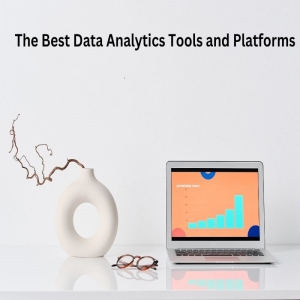The Best Data Analytics Tools and PlatformsPosted by Bhagat singh on June 1st, 2023  IntroductionData Analytics is becoming increasingly important in today's digital world. As the complexity of data increases and more organizations begin to turn to automated solutions, understanding the nuances of data analytics is critical. To help you understand the landscape, let's discuss the best data analytics tools and platforms available today. Data analytics platforms provide businesses with a powerful way to leverage their data for insights. By using various algorithms and data science methods, businesses can gain valuable insights from their data sets and better understand customer behaviors or trends among other objectives. There are many different types of tools used in this process, including artificial intelligence (AI), machine learning (ML), cloud computing, business intelligence (BI), predictive analytics, natural language processing (NLP), and more. You can also read: Marketing Strategies | Harnessing the Power of Successful Campaigns The benefits of utilizing a platform for data analytics include greater accuracy with analytics results; improved organizational workflow; increased scalability; enhanced security; reduced costs; and quicker access to insights into customer behavior or market trends. Additionally, many platforms offer integration options that allow businesses to integrate with third-party programs such as Salesforce or Microsoft Power BI for even more analytical capabilities. What is Data Analytics?In this blog, we will explore the best data analytics tools and platforms available for businesses. We will discuss what data analytics is, overview some of its popular tools and platforms, as well as examine types of analysis and its various benefits. First off, let us understand what data analytics is. Data analytics is a method of examining raw data to conclude patterns and trends in the data. With proper analysis, businesses can make informed decisions based on quantifiable evidence instead of intuition or subjective experience. There are many different tools and platforms for analyzing data, such as Microsoft Excel or Tableau. Each tool offers different capabilities which may be better suited for a specific job or task. For example, Tableau provides powerful visualizations while Excel offers robust functions for manipulating large datasets. A good understanding of the different tools available will help you devise an effective plan to analyze your own business’s data. When it comes to types of analysis there are three main categories: descriptive, predictive,e or prescriptive analytics. Descriptive analysis focuses on describing what has already happened in a given dataset; the predictive analysis focuses on predicting what might happen in the future; while prescriptive analysis looks at both past and present information suggesting which actions should be undertaken to attain the best possible outcome in a certain situation (e.g., which customer segment should receive a specific marketing promotion). Examples of Commonly Used Data Analytics Tools and PlatformsOne of the most popular databases for data analytics is MySQL. It enables users to store, update, and retrieve information quickly and efficiently from a wide range of applications. You can also integrate it with many programming languages such as PHP or Python. MySQL works best when dealing with largescale datasets and is used by companies big and small for their analytics solutions. You can also read Best Work From Home Jobs | Everything Explained in Detail! Many businesses also use Hadoop for data processing and analysis. It’s an open-source software framework that helps run distributed applications over a cluster of computers. Hadoop is great for managing large datasets that require big storage capacity because it enables scaling out across multiple servers with ease. Additionally, its ability to process streaming data makes it ideal for real-time decisions related to customer behavior such as fraud detection or communication preferences. Benefits of Using Data Analytics PlatformsOne of the primary benefits of using a data analytics platform is improved analysis insights. By leveraging powerful tools and intuitive dashboards, companies can gain a detailed understanding of their customer and user segments. For example, a data analytics platform can offer enhanced customer segmentation capabilities by tagging customers into different groups based on demographic or behavioral characteristics. This segmentation allows businesses to uncover hidden trends and create targeted marketing campaigns more easily. Another benefit of using a data analytics platform is increased access to data from multiple sources. This includes both internal sources such as databases as well as external datasets from third parties. Additionally, many platforms feature built-connectors that make it easier to integrate with other systems such as CRM or ERP solutions. This ensures that all relevant data points are available in one location and can be accessed quickly and efficiently when needed. Data processing is also made easier with the use of a good analytics platform due to its ability to automate certain processes such as extracting key information from large datasets or generating reports in seconds. Not only does this save time but it also eliminates potential errors associated with manual processes so you can trust the accuracy of your results. Tips for Choosing the Right Data Analytics Tool or PlatformYou should review your current requirements to understand what information is needed from the tool or platform. For example, are you looking for an all-in-one solution that allows you to process massive amounts of data? Or perhaps a cloud-based solution that’s quicker and easier to use? Or maybe something simple like Excel that’s less expensive, yet still provides reliable analysis? You should also consider whether the tools need to integrate with existing software or databases so there’s no disruption when transferring data. Additionally, security protocols should be taken into account since different programs may have varying levels of user access. The next step is researching potential solutions and assessing whether they meet your specific criteria. Focusing on key areas like scalability, features, flexibility, and cost can help narrow down your choices. You can also seek advice from industry leaders as well as trusted partners who have expertise in this area. Challenges to Overcome When Working with Data Analytics ToolsHowever, working with these powerful tools can carry a host of challenges. One of the most common issues is complexity. Data analytics tools are feature-rich and can take weeks or months to truly understand. It also requires that you have a strong foundation in mathematics and programming concepts. You can also read: Best Inspiring Goal Setting Quotes for Motivation If you are just beginning your journey with data analytics, it is essential to start small. Start by learning the basics of a particular tool or platform like creating visualizations, linking data sources, and exploring prebuilt datasets. From there, you can gradually increase the complexity of problems and analyses you tackle by using more sophisticated features. It's also important to keep up with best practices for using data analytics tools and platforms. As technology evolves rapidly in this space, it’s essential to stay informed on which tools provide the most value for your specific needs as well as any new capabilities that could save time or resources when working on larger projects. Additionally, become familiar with what types of data these tools handle best so you get the most accurate results possible from your analysis. Top 10 Popular and Best-Rated Data Analytics Tools and PlatformsFrom analyzing trends to visualization capabilities, each platform offers something different so you can make the most informed decision based on your needs. Before we jump into the list, let's take a look at what data analytics is and why it is so important. Data analytics is the practice of deriving insights from datasets by employing statistical methods, machine learning algorithms, and advanced models. It is used to aid in decisions making, product development, market segmentation, market optimization, and more. Data Analytics allows organizations to better understand their business operations and improve their strategies by helping them better understand customer behaviors through predictive analysis. Now that we’ve covered what Data Analytics is, let's move on to the list of the top 10 popular and best-rated data analytics tools and platforms: 1. Google Analytics: Mastering customer insights with Google’s powerful analytics capabilities for analyzing site traffic & understanding user behavior. 2. Tableau: A comprehensive set of software products designed for exploring large datasets & gaining visual insights from any source. 3. Microsoft Power BI: Turn raw data into meaningful visuals with this powerful reporting & visualization tool from Microsoft. 4. Looker: Use Looker’s modern analytics platform for creating beautiful dashboards with real-time insights & query optimization features. How to Choose the Right Tool for Your NeedsResearching your options is an essential first step in finding the best solutions for your data analytics needs. Dig into some research on the top software platforms and tools out there – look at their costs, feature sets, and customer feedback scores – so you can make an informed decision about which one might be the right fit for you. In addition to researching solutions that are available on the market today, it’s important to understand precisely what data you need to analyze to choose a tool that meets those needs. Gather as much information as possible before deciding so you can rest assured that the platform or tool you select will offer robust capabilities in areas including the analysis of large volumes of data quickly and accurately. Compatibility and connectivity are key considerations when selecting a data analytics tool or platform; many solutions offer connectors such as APIs that allow integration with existing systems or from external sources such as social media or public datasets. Make sure any solution you choose is capable of integrating with other software platforms that may already be in place. Like it? Share it!More by this author |


